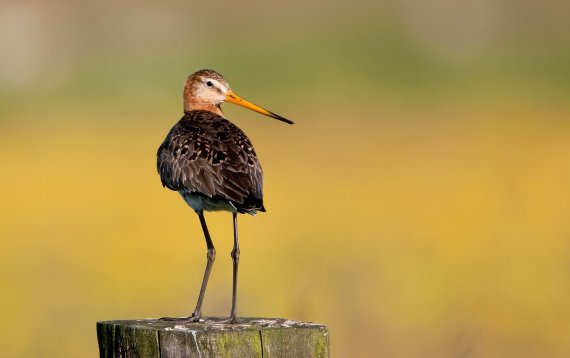© Shutterstock
The opening of the year is to take place largely online due to the corona restrictions, on 31 August. A small number of 30 guests will attend the ceremony; the remainder of the guests will follow the proceedings online. The usual programme, centred on a theme will take approximately an hour, and consists of a keynote speaker, two young researchers and the official opening by rector magnificus Arthur Mol.
Balanc
ing actThe topic of the day is “Nature and Agriculture: a continuous balancing act”. A surprising interpretation of this topic is offered through Ruben Smit Production’s latest project, the documentary Grutto! (black-tailed godwit). Cameraman Melchert Meijer zu Schlochtern will present and discuss the footage. The filming company resides on the campus, in Plus Ultra, and Ruben Smit is an alumnus. Wageningen researchers and alumi contributed to the production.
You might question whether the black-tailed godwit can even be called a Dutch bird; the creature spends nine months a year in Africa
Melchert Meijer zu Schlochtern
So: Grutto! Cameraman Meijer zu Schlochtern says the exclamation mark refers to the fact that the bird calls its own name. The subtitle of the production is “An iconic grasslands’ bird’s escape route”. Iconic, because the bird is a prominent feature of the Dutch rural regions. The black-tailed godwit was even elected “national bird” in 2016 and is considered symbolic for typically Dutch grasslands.
‘But, you might question whether the black-tailed godwit can even be called a Dutch bird’, Meijer zu Schlochtern says. ‘The creature spends nine months a year in Africa and only comes here to breed.’ The black-tailed godwit (Limosa limosa) is currently on its way back to Africa, or may already have arrived there. In Senegal, to be precise. Meijer zu Slochtern shot a great deal of footage there, as well as in Portugal, Spain and the Netherlands. Grutto! maps the bird’s entire living and migrating area.
So: Grutto! Cameraman Meijer zu Schlochtern says the exclamation mark refers to the fact that the bird calls its own name. The subtitle of the production is “An iconic grasslands’ bird’s escape route”. Iconic, because the bird is a prominent feature of the Dutch rural regions. The black-tailed godwit was even elected “national bird” in 2016 and is considered symbolic for typically Dutch grasslands.
‘But, you might question whether the black-tailed godwit can even be called a Dutch bird’, Meijer zu Schlochtern says. ‘The creature spends nine months a year in Africa and only comes here to breed.’ The black-tailed godwit (Limosa limosa) is currently on its way back to Africa, or may already have arrived there. In Senegal, to be precise. Meijer zu Slochtern shot a great deal of footage there, as well as in Portugal, Spain and the Netherlands. Grutto! maps the bird’s entire living and migrating area.
Difficult
However, much is amiss in this environment. The black-tailed godwit is in trouble. The population has been slashed by almost 70 per cent since the nineteen sixties as a result of profound changes in agriculture. And the decline continues. Intensive livestock farming is the main reason for the decrease in the amount of land suited for meadow birds such as the black-tailed godwit to breed. This film aims to provide insight into these processes.
The black-tailed godwit wasn’t born a meadow bird
Melchert Meijer zu Schlochtern
Particular attention is paid to the origin of the bird. The black-tailed godwit wasn’t born a meadow bird’, Meijer zu Slochtern explains. ‘They existed before there were pastures in the Netherlands.’ A filming crew travelled to Estonia to film related black-tailed godwits in the vast peat moors there. It is likely that our black-tailed godwit lived in the peat moors at some point, but adapted to cultivation.
Tv-serie
sGrutto! Is planned as a ninety-minute documentary. ‘But, we are also considering making it into a TV-series, similar to what was done with Wad en de Nieuwe Wildernis’, Meijer zu Schlochtern says. ‘The ratings were huge.’ Moreover, TV production is not quite as costly than producing a film. Most of the footage has already been shot. ‘But, next spring, we will benefit from a breeding season. You simply can’t film everything in just one season.’
Those who can’t wait till 31 August can view the youtube trailer (above).
Registration is required for the online opening of the academic year.

